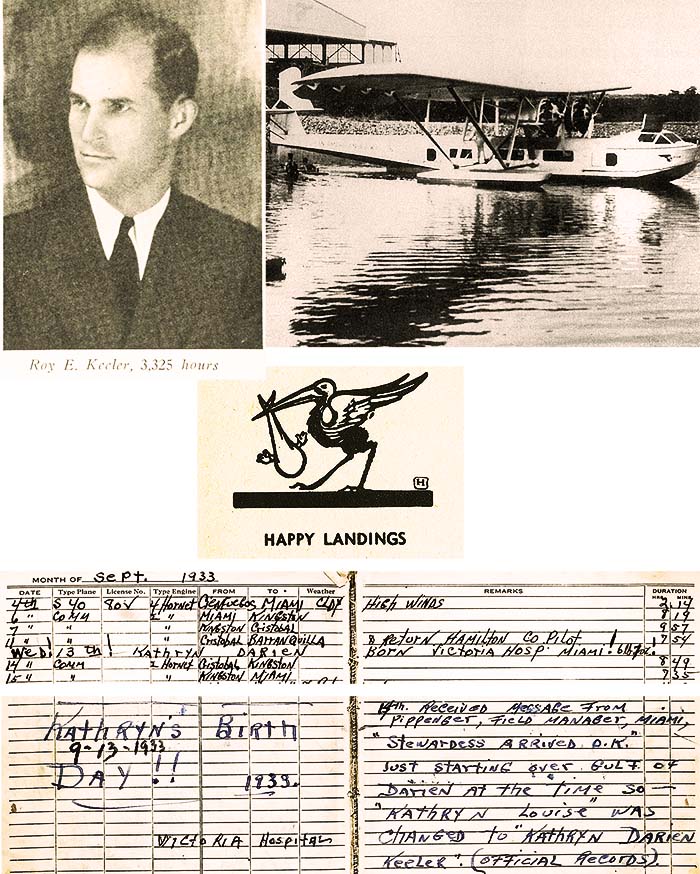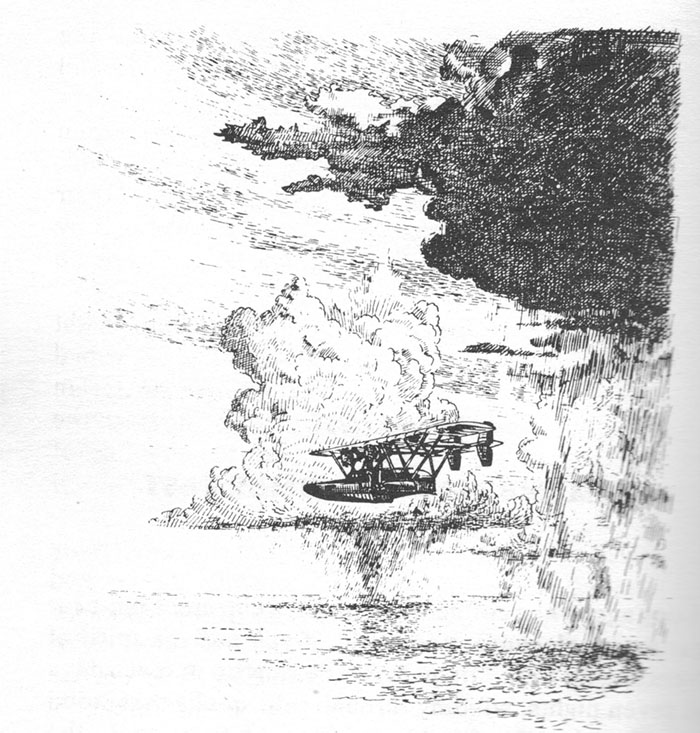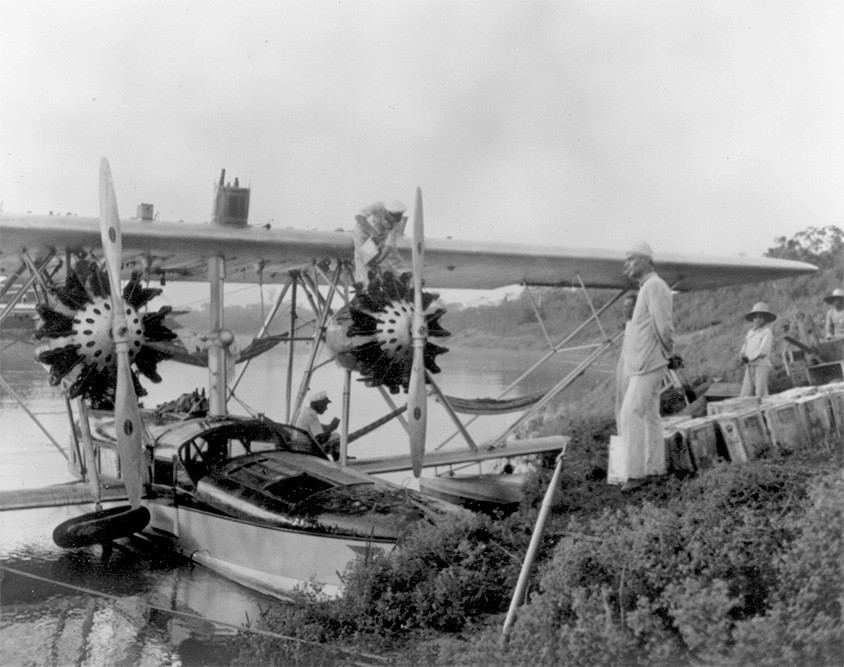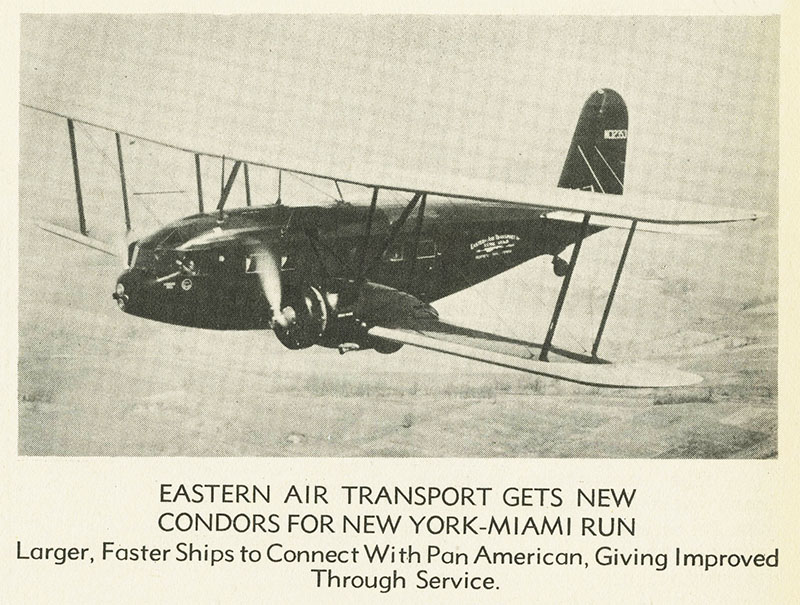OCTOBER 1933
Scroll down to read
Four October 1933 posts

Oct. 4, 1933
“A Booming Stork Market”
 Photo compilation:
Photo compilation:
• Captain Roy Keeler. "Pan American Air Ways,” Vol. 2, No. 3 April 1931 p.7.
• Consolidated Commodore (PAHF Collections)
•Stork cartoon. "Pan American Air Ways,” Vol, 4, No. 5, Oct. 1933, p.21
• Roy Keeler’s log for Sept. 1933 (Banning Collection. Pan Am Historical Foundation).
Eight new members of the Pan American Airways family were introduced across two continents in the October 1933 issue of Pan American Air Ways. Six girls and two boys joined the two-thousand-plus community, six in Miami and three further down the line in Havana, Costa Rica, and Brazil. Amidst the year’s less than stellar domestic and global economic news, the uptick in the stork market was welcomed news for the Carey, Culham, Fabrega, Galan, Keeler, Knapp, Rosenberg and Scott families.
Unlike the group’s other new fathers, Roy Keeler learned of his child’s arrival second hand. On Thursday morning, September 14, Chauncey “Slim” Pippinger, Operations Manager for the Caribbean Division, scrawled, “Stewardess arrived O.K.” on a Pan Am notepad and handed it off to the radio operator on duty. Pippinger’s announcement reached Keeler over his right shoulder, handed into the Consolidated Commodore’s cockpit soon after taking off from Cristobal on the first leg of the Panama – Miami return.
Roy been gone for eight days, having said goodbye to his wife, Emma, before dawn Wednesday, September 6, to fly to Panama via Cuba, Jamaica and Columbia. The couple had agreed on “Kathryn Louis” as a name; however, in his excitement at learning that Emma had delivered a baby girl Wednesday night, Roy made a spur-of-the-moment command decision: as recorded in his flight log “just starting over Gulf of Darien at the time so – “Kathryn Louise” was changed to “Kathryn Darien Keeler.”
Sources:
•"Pan American Air Ways", Vol. 4, No. 5, Oct. 1933) p. 22.
• Roy Keeler Logbook (Banning Collection. Pan Am Historical Foundation).
Oct. 11, 1933
“Bilgerats and Wheelholders:
Pan American Airways’ Second Generation of Pilots”
 Photo: Sikorsky S-38 Flying Boat in Flight. Illustration by Marius Lodeesen, "Captain Lodi Speaking," p. 130.
Photo: Sikorsky S-38 Flying Boat in Flight. Illustration by Marius Lodeesen, "Captain Lodi Speaking," p. 130.
The first pilots hired for Pan American Airways’ new ocean-flying training program -- Harry Canaday, Bob Ford, Haakon “Hack” Gulbransen, George King, Marius “Lodi” Lodeesen, Max Weber – trickled into Miami in October 1933. As Marius Lodeesen recalled, “There had never been a flying group like ours.” The first hires under Pan Am’s new pilot guidelines brought college degrees and army/navy commissions and 500+ flight hours to Clarence “Dutch” Schildauer’s from-the-bottom commercial pilot training program.
Assistant Operations Manager, Chauncey “Slim” Pippinger, greeted Lodeesen with an apprising look, a sigh and the aside, “another college punk/ What’s the world coming to?” before barking, “Before you strap your ass in the cockpit, you will polish every rivet in the hull and scrape out the bilge with paint remover!” Only after five-to-six months did the apprentice pilots fly as “combination men” able to “perform the duties of every crew member.”
To get there, writes Lodeesen, “We began with a federal airframe and engine mechanic’s license, authorizing us to make any repairs aloft or below and legally sign for work performed. We went on to get a federal radio operator’s license, second class, enabling us to man a telegraph station in flight or on the ground. In addition, we struggled with courses in international rules and signals, code of aviation, Marc St. Hilaire method of position computing, aerial navigation, celestial navigation, dead reckoning and piloting, ocean meteorology, semaphores.” “We,” whom Lodi named “bilgerats or wheelholders … were a hybrid between the skippers and the ground crew … who acted as co-pilot, flight engineer, radio operator, steward, and the captain’s valet and handyman.”
George King, then Lodi, followed by Hack ascended to captaincy in June 1937 after four years of flying that included Pacific crossings as Junior Flight Officers. Canaday, Ford and Weber soon followed.*
Company growth kept this intensive pilot training program going through the decade until the company’s shift into war mode made such training unrealistic.
* NOTE: Of this group, only George King did not retire from Pan Am; he died August 13, 1939, in a S-43 crash in Rio de Janeiro harbor.
Sources:
• Gene Banning, Airlines of Pan American since 1927, Paladwr Press, 2001, pp. 66 & 82.
• Harold Brock. Flying the Oceans. Steinhauer Press, 1978, pp. 39-53.
• Marius Lodeesen, Captain Lodi Speaking, Paladwr Press, 2004, pp. 27 & 51.
Oct. 17, 1933
“Singing Another Airline's Praises? Really?”
Eastern Air Transport Condor, “Pan American Air Ways,” Vol. 4, No. 2, April 1933, p. 3
https://digitalcollections.library.miami.edu/digital/collection/asm0341/id/41084/rec/2
Pan American Airways lauding another airline’s services in its in-house newsletter might seem odd. Still, when Eastern Air Transport placed five Curtiss Condor T-32C aircraft on the New York to Miami route starting October 15, 1933, it was good news for Pan Am.
That move cut the route’s travel time by 1/3rd (to ten hours), increased passenger load by 1/3rd, and beat the New York-Miami express train service by fourteen hours. Pan Am’s Caribbean and eastern South America passengers – north and south bound -- welcomed the improvement.
Pan American Air Ways told its readers, in its October issue:
“Pan American passengers arriving from the south can now spend the evening in Miami or Miami Beach, enjoy a restful night in a comfortable hotel and, leaving the next morning at 7:15, arrive in Washington at 5 P.M., New York at 7:30, or Chicago, via American Airways out of Atlanta, at 9 P.M.”
The Condor T-32C was a marked step forward in speed and passenger comfort compared to the four Ford Tri-Motors they replaced. Its sound insulation exceeded most aircraft, its 145 mph cruise speed made it Eastern’s fastest aircraft by far, and its tri-blade variable-pitch propellers were technological marvels.
However, Eastern’s Condors winged their way up and down the eastern seaboard for fewer than two years. As much as an improvement they were, they arrived obsolete. Even as the five bi-wings entered service, both Eastern Air Transport and Pan American Airways awaited Douglas’ DC-2 aircraft, an aircraft that signaled commercial aviation’s future.
Within twenty-four months of the first Condor’s landing in Miami, October 15, 1933, no Condors remained in Eastern Air Transport’s fleet.
Sources:
• “Eastern Air Transport gets new Condors for New York-Miami Run,” Pan American Air Ways, Vol. 4, No. 2 (Apr. 1933), p. 3.
• “Through tickets sold” Pan American Air Ways, Vol. 4, No. 5 (Oct. 1933), p. 5.
• “One-day service opens between Miami-New York.” Pan American Air Ways, Vol. 4, No. 5 (Oct. 1933), p. 5.
• Robert J. Serling, From the Captain to the Colonel (Dial Press, 1980), p. 118.
Oct. 24, 1933
“New Routes on Two Continents”

Photo: Can refueling Panair do Brasil Sikorsky s38 in Para, Brazil (PAHF Collection).
In 1933, no Western Hemisphere-based commercial airline had yet attempted three-continent service and none of Europe’s big four multi-continent carriers – Imperial Airways, Aeropostale, Deutsche Lufthansa, and KLM -- could match Pan American Airways’ October 25 single-day tour de force: new routes opened on two distant continents far from the airline’s home.
In China, pilot Bill Grooch, co-pilot Robert Gast, and radioman Bill Ehmer inaugurated CNAC’s (China National Aviation Corporation) new Route Three - a sky-link running along China’s coast from Shanghai’s Lungwha Airport south to Canton. Flying in one of CNAC’s two Sikorsky S-38s (NC 16-V) as Pan American Air Ways readers learned:
“The new service links the chief centers of coastal China - Shanghai, Wenchow (Wenzhou), Foochow (Fuxhou), Amoy (Zangzhou), Swatow (Shantou), Hong Kong, and Canton (Guangzhou) - on this strategic trade route to the principal world markets of the Far East. The airway, just short of one thousand miles in length, spans the coast of China from the Yangtse Delta, at Shanghai, along the East China Sea, the Straits of Formosa and the South China Sea as far as Pearl River.” (Contemporary city names added for clarification.)
Meanwhile, 10,000 miles and eleven time zones east, Capt. Mike LaPorte left Belém, Brazil in another Sikorsky S-38 headed 800 miles west up the Amazon River to inaugurate Pan Am do Brasil’s Belém-Manaus airmail, airfreight, and passenger service. Carrying mail bags, a Pan Am representative, and a Brazilian State Governor, the Sikorsky took off at 6:00 am and arrived in Manaus eleven hours later following stops at Breves, Gurupá, Prainha, Santarém, Óbidos, Parintins, and Itacoatiara -- names as exotic to North American ears as those along CNAC’s Route Three. Pan Am personnel had to roll with such linguistic challenges: they had mastered Tegucigalpa in Honduras and Antofagasta in Chile, after all.
Sources:
Gene Banning, "Airlines of Pan Am Since 1927" (Paladwr Press, 2001), p. 248.
Gregory Crouch, "China’s Wings" (Bantam Books, 2012), p. 56.
“Service on China Coast Started on October 24th” Pan American Air Ways, Vol 4, No. 5 (October 1933), p. 2.
Go back to "90 Years Ago" main page

